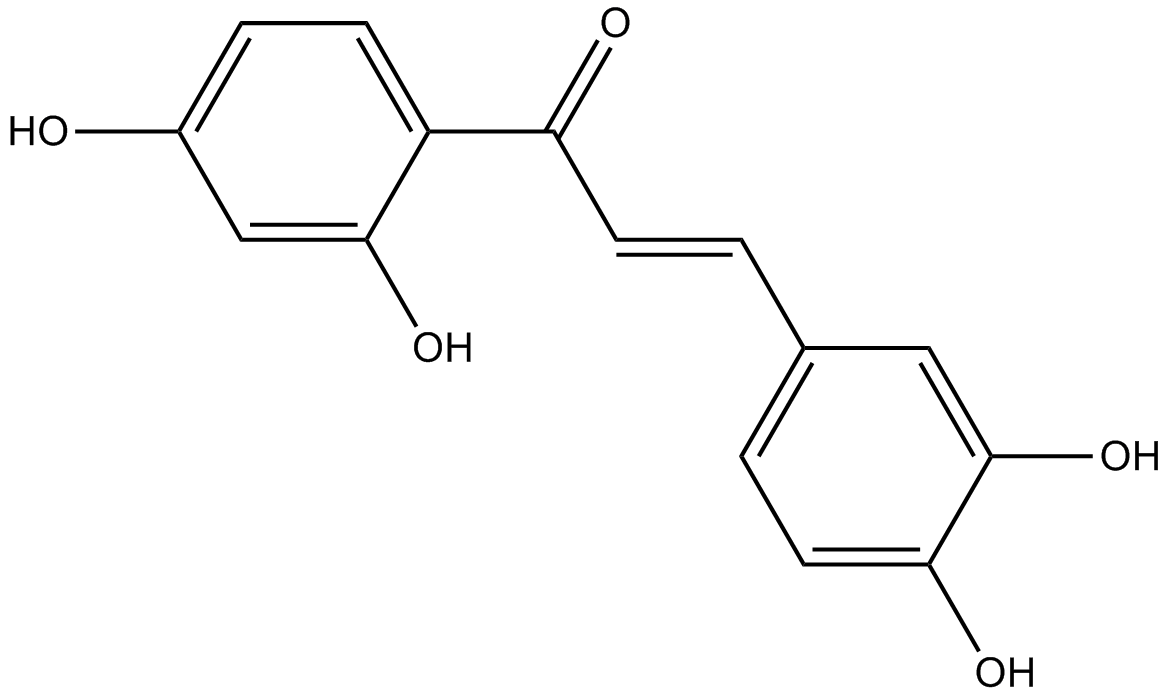Butein (Synonyms: 2’,3,4,4’tetrahydroxy Chalcone) |
| Katalog-Nr.GC10944 |
Butein ist ein cAMP-spezifischer PDE-Inhibitor mit einer IC50 von 10,4 μM fÜr PDE4. Butein ist ein spezifischer Protein-Tyrosinkinase-Inhibitor mit IC50-Werten von 16 und 65 μM fÜr EGFR und p60c-src in HepG2-Zellen. Butein sensibilisiert HeLa-Zellen fÜr Cisplatin Über AKT- und ERK/p38-MAPK-Wege, indem es auf FoxO3a abzielt. Butein ist ein SIRT1-Aktivator (STAC).
Products are for research use only. Not for human use. We do not sell to patients.

Cas No.: 487-52-5
Sample solution is provided at 25 µL, 10mM.
Butein, a chalconoid has anti-oxidant effect, which has various pharmacological effects.
Reactive oxygen species (ROS), produced intracellularly through multiple mechanisms and depending on the cell and tissue types, mainly ROS NADPH oxidase (NOX) complexes in cell membranes, mitochondria, peroxisomes, and endoplasmic reticulum, via dental adhesive bleaching agents and pulpal disease, can cause oxidative stress. [1] ROS are formed as a natural product of the normal metabolism of oxygen and have important roles in cell signaling and homeostasis. However, during times of environmental stress, ROS levels can increase dramatically.[2] H2O2-induced cytotoxicity and production of ROS were blocked in the presence of butein, and these effects were dose dependent.Due to the dual role of ROS, both prooxidant and antioxidant-based anticancer agents have been developed.
Butein can induce the apoptosis in B16 melanoma cells and human promyelocytic leukemia cells, inhibit diabetes complications, and inhibit enzymes such as protein kinases and glutathione reductase. [3,4,5,6] Recently, Butein was isolated from R. verniciflua which suppress cellular damage from oxidation caused by H2O2 in HDP cells, through JNK–Nrf2/ARE-dependent HO-1 expression.[7] In addition, Butein attenuated VEGF and MMP-9 activities via the suppression of NF-kB activity by flow cytometric analysis and RT-PCR in vitro. Furthermore, Butein repressed the expression of VEGF and MMP-9 induced by treatment with tumor necrosis factor-ɑ and phorbol-12-myristate-13-acetate mainly through Electrophoretic mobility shift assay (EMSA) and Enzyme-linked immunosorbent assay (ELISA), resulting in an inhibition of cell growth, invasion and angiogenesis of prostate cancer .[8] Thus, Butein may be a promising therapeutic agent for the treatment of various dental diseases.
References:
1.Han D, Williams E, Cadenas E."Mitochondrial respiratory chain-dependent generation of superoxide anion and its release into the intermembrane space". Biochem. J. 2010, 353 (2): 411-6.
2.Devasagayam, TPA; Tilak JC; Boloor KK; Sane Ketaki S; Ghaskadbi Saroj S; Lele RD. "Free Radicals and Antioxidants in Human Health: Current Status and Future Prospects". Journal of Association of Physicians of India (JAPI), 2004, 52: 796.
3.S. Sogawa, Y. Nero, H. Ueda, T. Miki. Protective effects of hydroxychalcones on free radical-induced cell damage. Biol. Pharm. Bull., 1994, 251-256.
4.J.C. Lee, K.T. Lim, Y.S. Jang. Identification of Rhus verniciflua Stokes compounds that exhibit free radical scavenging and anti-apoptotic properties. Biochim. Biophys. Acta, 2002, 181-191.
5.S.M. Yu, Z.J. Cheng, S.C. Kuo. Endothelium-dependent relaxation of rat aorta by butein, a novel cyclic AMP-specific phosphodiesterase inhibitor. Eur. J. Pharmacol., 1995, 69-77.
6.K. Iwashita, M. Kobori, K. Yamaki, T. Tsushida. Flavonoids inhibit cell growth and induce apoptosis in B16 melanoma 4A5 cells. Biosci. Biotechnol. Biochem., 2000, 1813-1820.
7.Dong-Sung Lee.et al. Butein protects human dental pulp cells from hydrogen peroxide-induced oxidative toxicity via Nrf2 pathway-dependent heme oxygenase-1 expressions.Toxicology in Vitro, 2013, 874-881.
8.Dong-Oh Moona.et al. Butein suppresses the expression of nuclear factor-kappa B-mediated matrix metalloproteinase-9 and vascular endothelial growth factor in prostate cancer cells. Toxicology in Vitro, 2010,24(7) ,1927-1934.
Average Rating: 5 (Based on Reviews and 16 reference(s) in Google Scholar.)
GLPBIO products are for RESEARCH USE ONLY. Please make sure your review or question is research based.
Required fields are marked with *




















